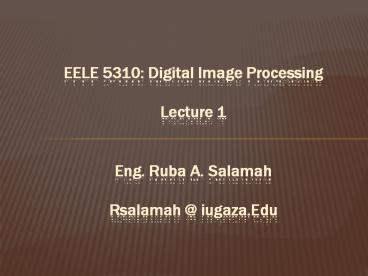EELE 5310: Digital Image Processing Lecture 1 Eng. Ruba A. Salamah Rsalamah @ iugaza.Edu - PowerPoint PPT Presentation
1 / 29
Title:
EELE 5310: Digital Image Processing Lecture 1 Eng. Ruba A. Salamah Rsalamah @ iugaza.Edu
Description:
Title: EELE: Digital Image Processing Lecture 1 Eng. Ruba A. Salamah Rsalamah_at_ iugaza.Edu Author: rsalamah Last modified by: rsalamah Created Date – PowerPoint PPT presentation
Number of Views:484
Avg rating:3.0/5.0
Title: EELE 5310: Digital Image Processing Lecture 1 Eng. Ruba A. Salamah Rsalamah @ iugaza.Edu
1
EELE 5310 Digital Image ProcessingLecture
1Eng. Ruba A. SalamahRsalamah _at_ iugaza.Edu
2
Course Objectives
- To Cover the basic theory and algorithms that are
widely used in digital image processing. - To Expose students to current technologies and
issues that are specific to image processing
systems. - To Develop hands-on experience in using computers
to process images. - Familiarize with MATLAB Image Processing Toolbox.
3
Recommended Textbook
- Digital Image Processing by R.C. Gonzalez and
R.E. Woods, 3rd edition, Pearson Prentice Hall,
2008 - Additional readings on the class website
4
Prerequisites
- Knowledge of the following three areas
- -Linear Algebra.
- -Elementary Probability Theory.
- -Signals and Systems.
5
Grading Policy
- Quizzes 15
- H.W 10
- Attendance 10
- Projects 20
- FinalExam45
6
Course outline
- Introduction
- Digital Image Fundamentals
- Image Enhancement in the Spatial Domain
- Image Enhancement in the Frequency Domain
- Image Restoration
- Image Compression
- Image Segmentation
- Representation and Description
7
Fundamentals of Digital Image Processing
8
What is a Digital Image?
- A finite array of data values
9
What is Image Processing
- Processing digital images by means of a digital
computer. - Image processing typically attempts to accomplish
one of three things - Restoring Images
- Enhancing Images
- Understanding Images
- Restoration takes a corrupted image and
attempts to recreate a clean original - Enhancement alters an image to makes its
meaning clearer to human observers - Understanding usually attempts to mimic the
human visual system in extracting meaning from an
image
10
Three Types of Processes
- Low-level Processes
- Involve primitive operations such as image
preprocessing to reduce noise, contrast
enhancement, and image sharpening. - A low-level process is characterized by the fact
that both its inputs and outputs are images. - Mid-level Processes
- Involves tasks such as segmentation (partitioning
an image into regions or objects), description of
those objects to reduce them to a form suitable
for machine learning , and classification(recognit
ion) of individual objects. - Its inputs generally are images, but its outputs
are attributes extracted from those images (e.g.,
edges, contours, and the identity of individual
objects).
11
Three Types of Processes
- High-level Processes
- Processing involves "making sense of an ensemble
of recognized objects, as in image analysis, and,
at the far end of the continuum, performing the
cognitive functions normally associated with
vision.
12
Applications
- Processing of remote-sensed images via satellite.
- Radar, MRI, Ultrasonic image processing.
- Noise Reduction.
- Character recognition.
- Automatic inspection of industrial parts.
- Content based image retrieval.
- Biometrics.
- Target tracking.
13
Sources of Energy for Image Formation
- The principle energy source for images is the EM
spectrum - Other sources include ultrasonic, electronic, and
synthetic images.
14
Some Applications -- Medical Diagnostics
15
Some Applications -- MRI
16
Some Applications -- Microscopy
17
Some Applications -- Industrial Inspection
18
Some Applications -- Remote Sensing
19
Some Applications -- Transmitting Images
20
Key Stages in Digital Image Processing
21
Image Acquisition
22
Image Enhancement
23
Image Restoration
24
Morphological Processing
25
Segmentation
26
Object Recognition
27
Image Representation Description
28
Image Compression
29
Colour Image Processing













![[Rapid Housing Prototyping] ddf.mit.edu Digital Fabrication and Housing Delivery Systems PowerPoint PPT Presentation](https://s3.amazonaws.com/images.powershow.com/7382501.th0.jpg?_=20151116108)

















